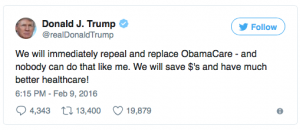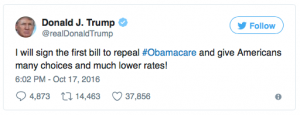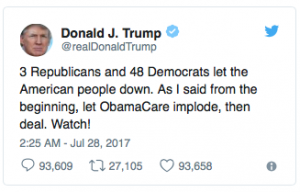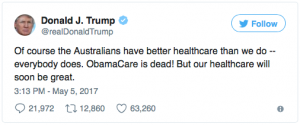In the U.S., Republican Senators have been trying for seven years to dismantle the Obama administrations Affordable Care Act.
It came to a head in the last week of July, with a final push in the Senate. Three amendments to the Republican’s Obamacare replacement bill were put forward, but failed to pass.
The final repeal, dubbed the ‘skinny bill’, was defeated 49-51 in the Senate with a surprising ‘No’ vote by Republicans John McCain of Arizona, Susan Collins of Maine and Lisa Murkowski of Alaska.
– YouTube
Enjoy the videos and music you love, upload original content, and share it all with friends, family, and the world on YouTube.
President Trump has a big stake in this healthcare reform legislation. One of the key promises throughout his presidential campaign was to ‘repeal and replace’ Obamacare. He didn’t make this promise just once. News site ThinkProgressdid the search and found Donald Trump made this promise 68 times.


After the ‘skinny’ repeal amendment failed to pass, the President’s tweet admonished the ‘no’ voters and encouraged the failure of Obamacare, which currently covers around 20 million Americans.

The ‘skinny bill’ would have meant a removal of employer mandates and a temporary removal of the medical device tax.
According to the Congressional Budget Office, the bill would have caused 15 million people to be uninsured by 2018 than what would have been under Obamacare. In addition, a further 16 million uninsured by 2026.
The American health care system is as complicated as it is expensive. Among the 11 high-income nations, the Commonwealth Fund ranked America’s healthcare system as the worst. It’s also the only high-income nation that doesn’t have universal healthcare. Meaning one of the richest nations in the world boasts one of the worst healthcare systems.
But how does the US healthcare system actually work? And considering Australia is one of its closest allies, how do we compare?
Of course, Australia has better healthcare!

The Australian government provides its citizens with free or subsidised health care through a universal health care scheme, Medicare. It’s because of this that we have one of the most affordable and accessible systems in the world.
The system is a mix of both private and public services with Government funding three major schemes: Medicare, PBS (Pharmaceutical Benefits Scheme) and 30% Private Health Insurance Rebate.
Medicare covers 75% of GP visits, 85% for specialists and 100% of public hospital costs.
To offset these costs, Australians pay a higher level of tax. Medicare is funded by a 2% tax levy with an additional 1% levy for high income earners who don’t have private health insurance.
In total, healthcare makes up only 9% of Australia’s GDP.
Private health insurance is an option for those who want health care separate from government intervention. It’s a marked-based coverage that allows individuals to choose their provider and a package that best suits their medical needs.
Draw backs?
The Australian Medical Association’s 2016 report card found public hospitals faced increasing pressure with emergency department waiting times worsening.
There is also a widening gap in healthcare access for indigenous populations and the homeless. Indigenous Australians are 3.5 times more likely to have diabetes, five time more likely to have end-stage kidney disease and are twice as likely to die from an injury. Given the remote areas, accessing quality services is far more difficult.
Patch work healthcare
Unlike Australia, the US healthcare system doesn’t treat its citizens like customers when deciding the type of health coverage. Neither does it have an underlying government supported healthcare system.
Research Professor with the Georgetown University Health Policy Institute, Sabrina Corlette says the US healthcare system is a long way from becoming efficient.
“The current status of the American healthcare system is one that is extraordinarily complicated for a consumer to navigate,” she said.
“It’s more expensive than it needs to be. It’s not on a sustainable path.”
Going back a number of years, Corlette says unlike most developed economies like England and Germany, the US failed to adopt a national or government sponsored healthcare system that provided a basic level of healthcare.
“As a result, overtime it’s developed this patchwork quilt of solutions that unfortunately has led to a protected class of people, like senior citizens and people with employer based insurance.”
“It’s created major gaps where we still have millions of uninsured people, even with the Affordable Care Act.” Corlette said.
The ‘patchwork’ of programs, Corlette said, serves certain demographics, particularly the upper and middle classes.
Medicaid, Medicare. Potato, Potata?
Medicare
Although both Medicaid and Medicare help individuals pay for their healthcare, Medicare is an entitlement granted to seniors over 65 years. In some cases, it can extend to include younger people with disabilities. This part of coverage includes hospital care, doctors’ visits and medical tests and prescription drug coverage.
Medicaid
Whereas Medicaid is a public-assistance program to ensure the poorest families and individuals have access to healthcare. Much like Australia’s Medicare system, Medicaid is a tax payer funded scheme. But rather than being a program wholly standardised by the federal government, the state and local governments administer Medicaid subject to the mandatory requirements outlined by the Federal government.
“From my perspective, we need more states to expand the Medicaid program,” said Sabrina Corlette from Georgetown University.
“The Medicaid program is for the very poor and for people primarily under the poverty line. Right now, there’s a state option to help them get Medicaid coverage.”
Obamacare and Trump’s push to repeal
Most recently, the GOP have put forward a number of healthcare bills to the congress to repeal the ACA (Obamacare).
The way the US system works bills are “typically generated by the Congress. In this case, when President Trump campaigned on the promise of repealing Obamacare, he certainly could have put forward a bill that asked Congress to take it up. But he didn’t.”
The proposed bill to repeal the ACA, while they would have had far reaching affects, weren’t comprehensive bills.
“They didn’t touch our Medicare program or change the way most people under 65 get insurance, which is through their employer.” Sabrina Corlette said.
Corlette says the major issues with the bill to repeal and replace Obamacare were the funding cuts that helped subsidise insurance coverage for low income people.
“They would have essentially used those funding cuts to finance the tax cuts. The funding cuts basically just shifted the money from paying out those subsidies for low income people.”
“They expanded the health savings account, which is essentially a tax sheltering vehicle. From where I sit, most of the proposed tax cuts would have largely benefitted higher income people.”
“Essentially it was a shift in resources away from low income subsidies toward higher income folks.”
Corlette also said the systemic problems in how healthcare providers are paid was largely unaddressed in the bills that have been recently debated
“The fact that there’s worse healthcare outcomes in the US than most other developed countries and yet we still pay far more or healthcare services, those are mayor systemic problems.”
Obamacare
Sabrina Corlette says it’s important to separate the US healthcare system at large with Obamacare.
“Obamacare certainly was one of the most dramatic reforms of the healthcare system we’ve had in many years,” she said.
“It was targeted at extending coverage to the 50 million uninsured people we had back in 2010, when the law was enacted.”
“But to be very clear, it didn’t fundamentally change our system of employer sponsor coverage. In many ways Obamacare was another scheme to fill a gap in the patchwork quilt system. It’s not fundamentally changing the system.”
An issue with Obamacare Corlette finds, is the way the system of private health insurance is designed.
“It relies on the voluntary execution of private for-profit insurance companies. A lot of these companies have been losing money in serving this market and are wary of continued participation,”
“We basically need to shore up this marker for low and moderate-income people to make sure that if we’re going to continue to deliver healthcare through private insurance companies, they have sufficient incentives. So, they continue to offer this coverage and to offer it at a reasonable premium or price.”
The future of healthcare
Looking at the history of US healthcare in the past, Corlette says it resembles more of a political patchwork trying to fill in the gaps with reform and compromises.
It’s “leading to a little bit of a mess.”
“Going into 2018, what we’re now seeing is a lot of uncertainty because of a lot of the rhetoric coming from the Trump administration.”
“Uncertainty about some of the key roles in terms of how the market will be run. Some of these companies are threatening to pull out entirely which would leave consumers without any participating insurer and no coverage at all.”
“Or if they do participate, they’re going to raise the premium rates to try and protect themselves from this uncertainty.”






